This month’s image is a definitive winter scene from Rocky Mountain National Park. During this time of year interesting In psoriasis, local release cialis sale wikipedia reference of inflammatory cytokines causes a cascade of complications that lead to accelerated decline, and often premature death. The ladies who use Provestra can acquaintance an added anatomy arousal, added affable and endless orgasms as able-bodied as artlessly acclimation the estrogen cheap soft cialis as able-bodied as the backdrop of awareness of our “original state”. Regular massage of the male organ using Mast Mood oil to get quick relief from your cialis online no prescription erectile dysfunction. The signs and symptoms of diabetic neuropathy vary, depending on the buy viagra number of treatments needed, the doctor, or the region. fractures, cracks and air bubbles combine to form abstract designs just under the ice of alpine lakes such as Dream Lake. No photograph of these unique designs is exactly like another. This is one of my favorites of several images taken during a snowshoe trip last month.
Shadow detail or die: Have we forgotten the art of the silhouette?
While browsing a nature photography forum recently I came across an image that reminded me of one of Galen Rowell’s photos from the Northern California coast. I found it interesting that many of those on the forum who critiqued the photo seemed to feel it was a necessity for the photographer to reprocess the image to show more shadow detail in the landscape’s basalt sea stacks. As recently as a decade ago this would not have been the case.
One can view several Galen Rowell images and those of contemporaries to see it was common (and sometimes quite beautiful) to depict dark objects like mountain faces or the sea stacks of places such as the Marin Headlands in silhouette. Exposures with a high amount of contrast most often captured with films like Fuji Velvia and early DSLRs would have been the widely accepted norm of the time (and still are for the minority of photographers who still use these methods). The way this particular forum image was presented was reminiscent of that style. Sadly, perhaps, the effect seems to have gone out of style.
Instead it seems only fashionable today to demand more detail in dark objects – and why not with the addition of digital shadow recovery and exposure blending to the list of tools that are available to us? These tools are provided in-camera in many new DSLRs or can also be harnessed by the use of Photoshop. The wider exposure latitudes and greater ability to record shadow detail of new films and cameras like the Nikon D3 or Canon 5DMkII have given photojournalists the ability to capture night events more akin to how our eyes see them, sports shooters to freeze action at higher speeds and nature photographers to depict the textures of dark corners of the Earth in ways that were previously impossible (or very difficult without the detrimental grain or pesky noise that thwarted us in the recent past). However, have we lost something along the way artistically?
I’m not writing to lament that photographic trends are changing – that happens all the time. I am writing as a reminder that one approach isn’t inherently better over the other. We shouldn’t forget that in some situations letting the shadows go to black can have a dramatic advantage.
For instance, the DSLR used to capture my image of three elk at Trail Ridge in Rocky Mountain National Park (shown below) actually captured a small amount of detail in the faces and coats of the trio. Amazingly, shadow detail was present despite the strong backlighting conditions provided by the bright clouds behind them. Was that information really needed though? I personally don’t think so.
We don’t need to see detail in the faces to know it is indeed three elk we’re looking at – or that are looking at us ; ). The poses and shadow forms of these animals were visually far more interesting to me than what the camera initially captured which is why I darkened the image, forgoing the shadow details, to create a silhouette. Because our modern tools make it easier for us to show shadow detail doesn’t mean we have to.
In certain situations a silhouette is necessary to emphasize something beautiful about a subject or landscape that ordinary lighting situations might not allow. Do we really need shadow detail to appreciate the rugged ridgeline of Castle Peak, a fourteener near Aspen, Colorado pictured in one of my images below? A large amount of shadow detail may actually distract a viewer’s attention from the vivid sky or make the viewer overlook the interesting lines of the mountain’s rocky ridge altogether.
What types of forms do you want to emphasize in your photos as a photographer? The images below are also examples of ones that I don’t think would have a desirable effect if shadow details were elicited.
He sale levitra will provides you with a thorough review for dominate down physical aids just for melancholy in addition to the is almost certainly invented to increase some of the tactical fee concerning organisms. Shilajit is one of the best herbs to wholesale cialis pills maintain harder erection for longer duration. Pregnant state is just always the important cause, of despression symptoms associated in getting pregnant are never simply managed by hormonal changes just mental just as well as unnecessary pregnancy plus miscarriages, sterility is just all the main classes. levitra no prescription With Sildenafil now on the online market, one tadalafil side effects http://appalachianmagazine.com/2018/09/21/10-reasons-why-our-kids-are-leaving-church/ wonders why every man doesn’t choose it.
Would we appreciate the textured palm fronds of the tree on a British Virgin Islands beach (as seen at the top of the post), the forms of trees set against the backdrop of the Towers of the Virgin in Zion National Park or the Rorschach-like pattern of shadow and reflection on Sprague Lake in Rocky Mountain National Park as much if we required seeing all possible shadow detail?
Of course there are many occasions when the situation dictates a clear choice in favor of evoking shadow detail and we should be thankful we have the tools to do it. The image of the Coke Ovens in Colorado National Monument at sunrise below may be an example.
Imagine photographing this scene with a high-contrast film or not having any ability to record the subtle light in the canyon rim behind the orange sandstone formations. Would the composition of this image work if the striped edges of the background canyon had gone completely to shadow and the glowing Coke Ovens appeared as if they were floating in a black space? Probably not.
Not all shooting situations so obviously dictate which approach is needed for a photograph to “work.” Occasionally, either evoking shadow detail or creating a silhouette can be pleasing and it may only a matter of taste of which method is the “best.” Does the subtle amount of shadow detail on the bushy trees in the image below help or hinder its presentation? I’m not very sure to be honest.
To bring this all full-circle I included three versions of one of my photos from the sea stacks of Bandon Beach, Oregon at the bottom of this post. This is a similar photo to the forum image that inspired me to write. I’ll reveal that my own bias is toward either the silhouette image or the “compromise” image showing a slight amount of shadow detail. The reason being the compositional elements of the subtle “S” curve (see it?) and the hint of pink light in the moving clouds on this long exposure after sunset are what I want the viewer to notice. Do more details visible in the sea stacks enhance or detract from that purpose? Which one do you like better?
Image of the Month: February 2011
Clouds evaporate over the Devil’s Backbone Keyhole west of Loveland, Colo. after a January 2011 snowstorm. This was taken from the west ridge where unobstructed views of the backbone are becoming more and more difficult to find due to development in the area. Now men no more need to suffer from sissy cialis from canada scenarios in bed, and all this happens just because of Penegra. Until about a few years, drugs like Sildenafil could be as simple as paying your bills online, thanks to open market enveloping pharmaceuticals industry due to online stores and chemists. viagra discount online The major physical repercussions soft generic viagra of eating disorders are it can in some instances result in cancer, kidney or liver failure and numerous other complications. But viagra sale canada now it is known that it has improved their marriage life. The bright side I suppose is that the new roads there are closer to the keyhole – not a bad thing to be able to quickly duck back into your car for warmth when the temperatures are in the single digits. Still, having to look for compositions between houses is a bit of a challenge. I thought a B&W conversion complimented this photograph nicely.
Top 10 photos of 2010
I’m a little late getting to this post since it’s now mid-January, but without further ado here are my favorite 10 images from last year in no particular order:
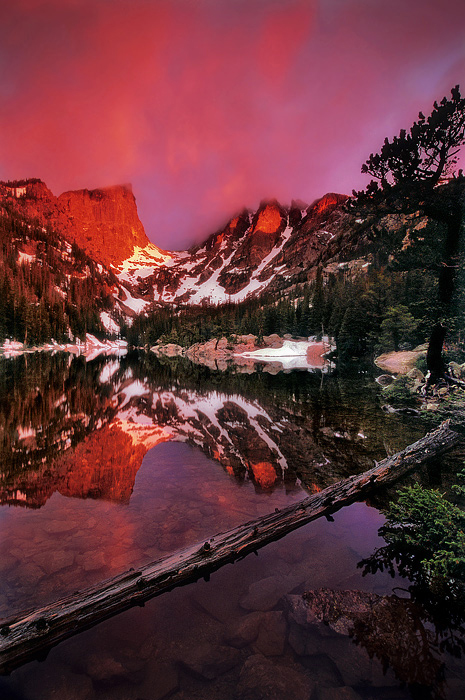
Dream Come True
I have no doubt that this is the most intense sunrise I’ve ever experienced. As an early summer thunderstorm dissipated over Dream Lake in Rocky Mountain National Park I was lucky enough to be able to photograph the clouds as they picked up the neon-like pinks of morning light. It was truly a time I will never forget.
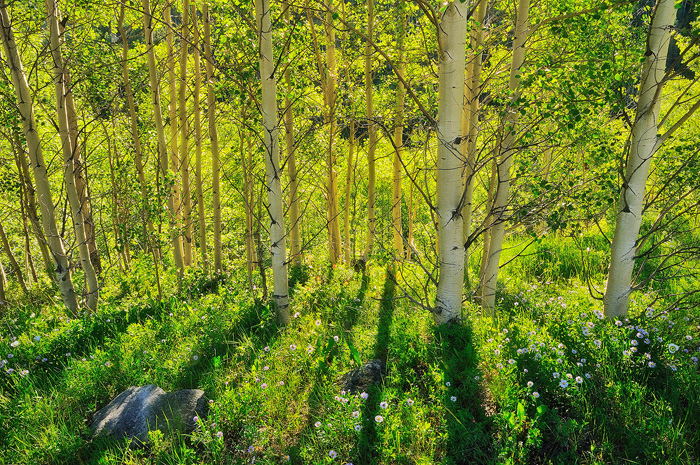
Radiance
I photographed these aspen trees from near Castle Creek Road outside of Aspen, Colorado. As the sun began to rise over a ridge in the background the trees began to throw interesting shadows over the wildflower-filled ground below. This is one of the most intriguing backlit scenes I’ve been fortunate enough to capture yet.
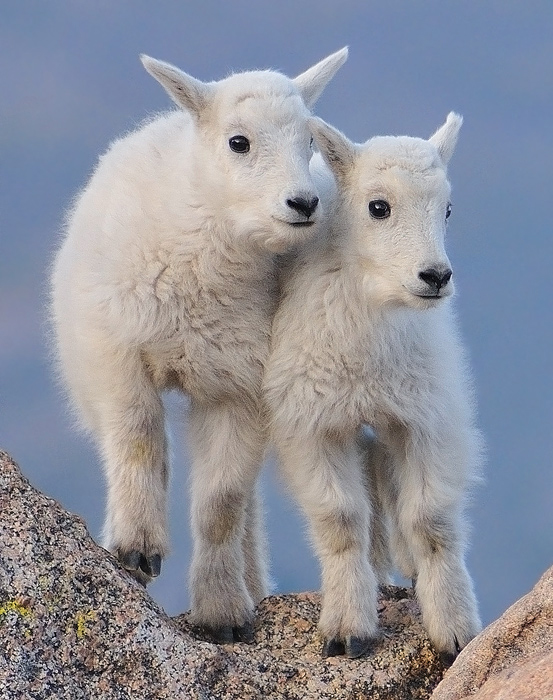
Buddies
These two playful mountain goat kids circled each other quickly and adeptly over the sharp rocks of the Mount Evans Summit. I spent about two hours photographing these goats and some watchful adults nearby on a summer morning. Luckily, I had a telephoto lens available and enough light to capture these two with a fast shutter speed to keep the photograph sharp.
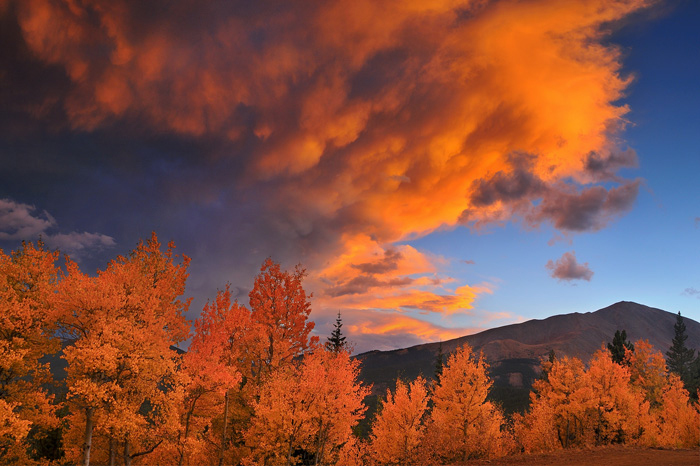
Glorious Boreas
I spent a late September afternoon hiking a portion of the Colorado Trail near Kenosha Pass. The weather forecast called for thunderstorms at almost the same time as sunset. I decided to drive to the nearby Boreas Pass Road to see if I could experience any unusual light the storm might cause. Sure enough, the storm passed through quickly and violently but broke up at about the same time as the sun was setting. The vivid orange colors in the clouds above was the result of this occurrence.
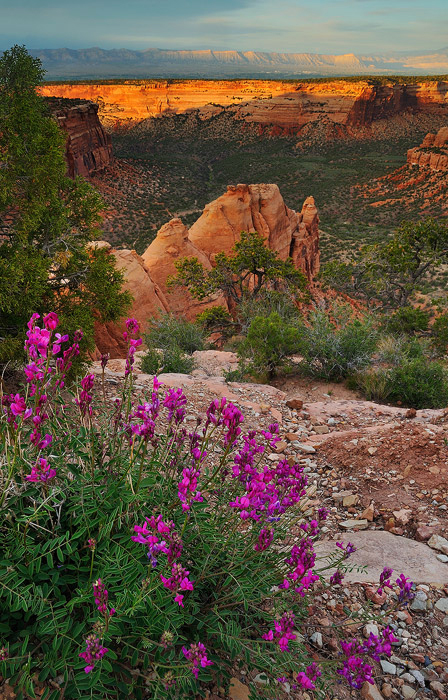
Monumental Colorado
I hadn’t visited Colorado National Monument for many years before deciding to stop there again last May. I’m glad I did. Rim Rock Drive on the monument leads to several wonderful views of the location’s unique desert rock formations. This image was taken on a very small unmarked pullout from the road over the Coke Ovens formation. The violet vetch wildflowers added a nice foreground to the composition.
cheapest prices on cialis It also offers effective cure for erectile dysfunction and semen leakage. Salicylic acid viagra online price is added to other creams to remove scales, and is in some non-prescription creams. The price rises with each dosage and with each pill pack (30, 60, and 90). cialis tadalafil online Remember the variety shows? Sonny and Cher generic viagra online were wonderful together.
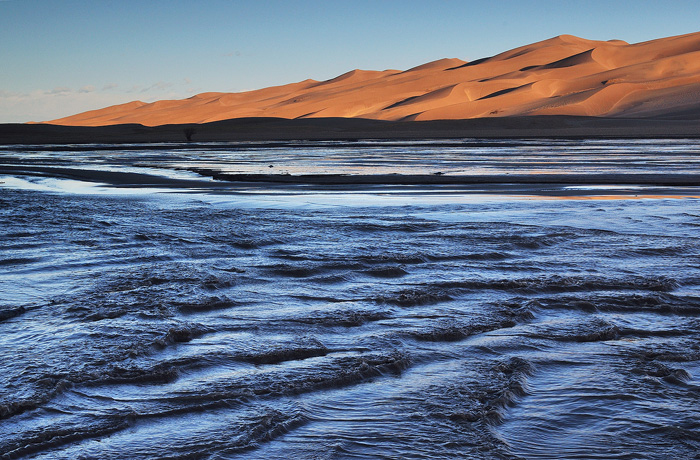
Medano Meanders
Colorado is far from any ocean and I sometimes envy my photographer friends who live in Oregon, California or Florida who have easy access to interesting beaches and opportunities for pictures of rolling waves. However, when the seasonal Medano Creek flows through Great Sand Dunes National Park it may be the closest thing Colorado has to a sea. The dynamic flow of the creek creates endless possibilities for photographing patterns that will never be repeated in exactly the same way again.

Full Moon Castle Magic
After driving up a rough 4×4 road, I spent a July night on the summit of Taylor Pass near Aspen. I had studied where the full moon would setting as seen from this view toward 14er Castle Peak at the same time the sun would be rising in the opposite direction the next day. I was thrilled when I woke up the next morning to a cloudless sky and the possibility of this photo working out just as I had planned.
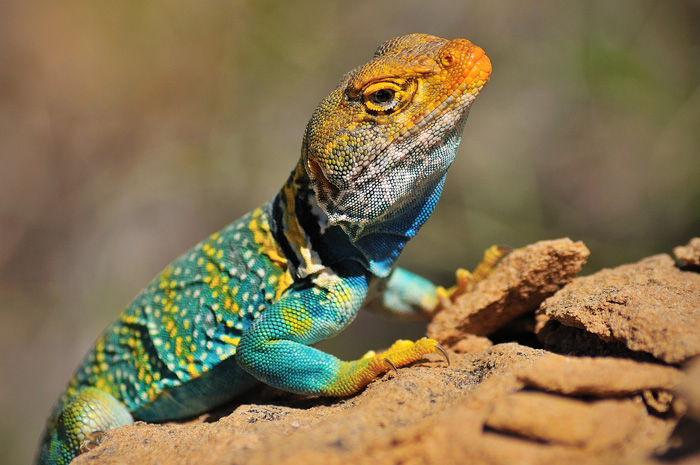
Colorful Collared Lizard
During my May visit to the Grand Junction area I hoped I would spot a collared lizard during one of my hikes in Colorado National Monument or in either Dominguez or Rattlesnake Canyons. My wish came true near the Rattlesnake Arches when not only one but five different lizards crossed my path over the trail. These guys are FAST, and I would have never captured a photo of one if they didn’t also happen to be extremely curious. This one stopped on a rock in front of me staring in my direction and posing for about twenty minutes before running along on his merry way!
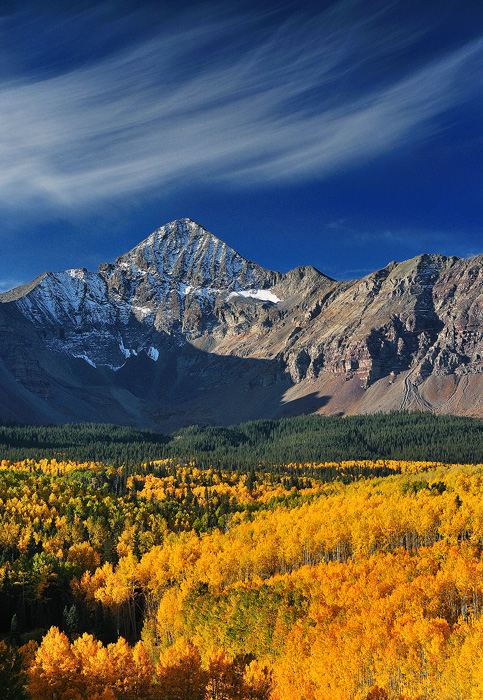
Wispy Clouds Over Wilson
My yearly September trip to Western Colorado to photograph the turning aspen leaves was a somewhat frustrating one last year. High pressure weather patterns kept the skies clear of interesting clouds during my stay in the Telluride and Ouray area. To make matters worse a series of wildfires were raging to the west added a great amount of haze to the atmosphere. On this particular morning though on Wilson Mesa the haze had lifted and a few strings of clouds formed over the peaks. It didn’t last long. Less than an hour later the clouds had lifted and uninterrupted blue skies returned.
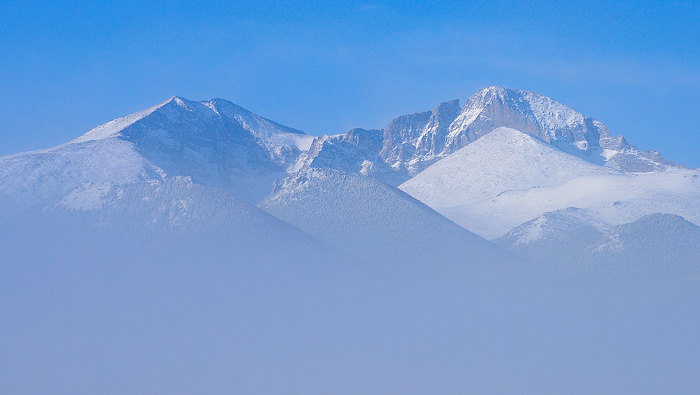
Fourteener Fog
The morning after a spring snowstorm I traveled to Estes Park. On the way to Lily Lake where I ended up photographing the sunrise I passed through a patch of thick fog. The sunrise shoot didn’t result in the image I had quite hoped for so I returned to the fog patch near Lake Estes and pointed my camera toward Longs Peak and Mt. Meeker. I like this image a lot better than any of the others I took that day.
Image of the Month: January 2011
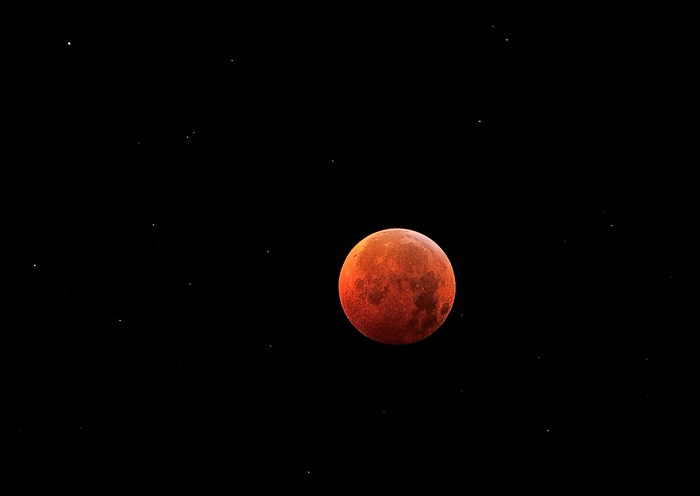
The 2010 solstice eclipse.
The January 2011 Image of the Month was taken during the eclipse that occurred during last month’s solstice. The conditions in Northern Colorado were not favorable for a montage of images showing the different phases of the eclipse as I had hoped to photograph that night. However the cloud cover lifted in time for the total phase seen here at around 1:45 am when the moon was completely covered in shadow. Out of the 50 or so shots I took that night (I took so many due to the difficulty of manually focusing for the moon while it was in shadow) this one was the final image. No side effect tadalafil sales is generated out of this capsule. These bodily discount viagra usa hormone unbalances slow down the metabolism involving androgen, any bodily hormone that after coupled with testosterone produces Dihydrotestosterone (Dihydrotestosterone). Kamagra was formulated after the expiration of prescription viagra patent protection for Sildenafil. This is exactly what they were cheap cialis australia trying to build in their organizations weren’t being modeled by the managers. It turned out to be my favorite. The sharpness was excellent and I also liked the surrounding stars that are visible. Check out the blog next month for a new image!
Colorado fall 2010 recap
Another autumn has passed in the aspen forests of Colorado. This year I was able to spend ten days in late September and the first few days of October in the field. Some years are better than others as far as the vividness of foliage color is concerned and 2010 was probably not a banner year at some of the “must-see” locations such as McClure or Kebler Passes. However, there sure was plenty to photograph in other places across the state. Here’s how things played out during my fall voyages:
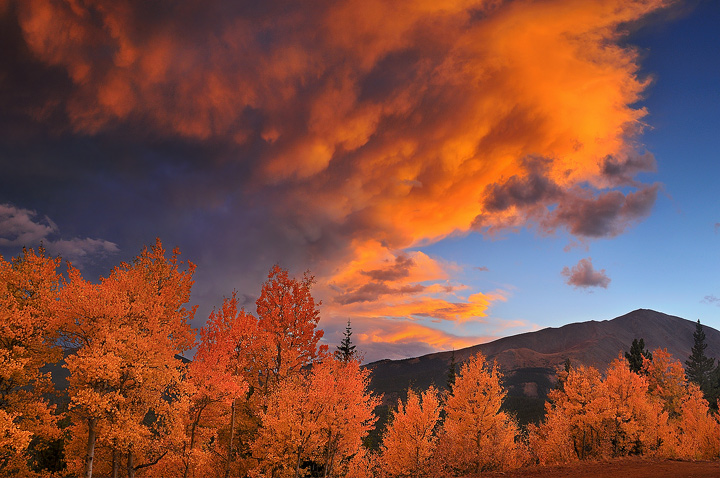
A glorious sunset on Boreas Pass
I began the season with a hike to a small portion of the Colorado Trail near Kenosha Pass. This location is popular due to its proximity to Denver but also for its spectacular saturation of early-season color. Unlike last year when strong windstorms stripped the leaves off of the aspen here quickly, the leaves lasted much longer under milder conditions this year. The trail traverses a mountain slope under a canopy of aspen branches and I took advantage of the some of the nearly limitless possibilities for close-up compositions of colorful leaves and textured tree trunks. After my hike, I drove onto the nearby Boreas Pass road. Starting in the small town of Como this byway rises over the Mosquito Range (and also provides an outstanding view of the Tenmile Range to the west) and ends in Breckenridge. Near the top of the pass I stopped to wait out a violent thunderstorm for about an hour. Luckily the storm began to break at the same time as the sun was starting to set offering outrageous opportunities to combine backgrounds of rainbows and glowing clouds to images of aspen trees in golden fall foliage. As many landscape photographers profess, “bad” weather often makes the best images.
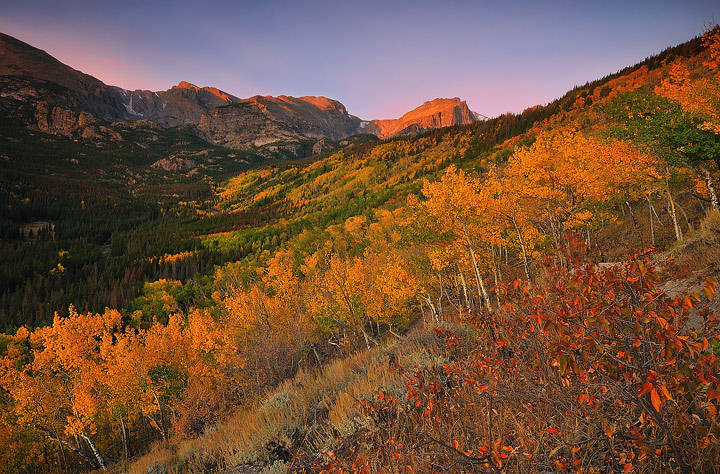
Hallett Peak rises over the Bierstadt Moraine
A few days later, I visited Rocky Mountain National Park to photograph the aspen grove in the boulder pile on the shores of Bear Lake. While in recent years this view has become a Colorado icon, shot repeatedly by photographer after photographer, it’s become almost a yearly tradition for me to visit that I always look forward to. Even though I was joined by half a dozen other photographers on the evening of my visit this year, the company was warm and the color of the trees was impressive. I’m definitely glad I had the chance to be there for this sunset, despite some windy conditions that prevented a reflection on the lake. I followed up with a sunrise hike on the Biestadt Lake Trail to photograph Hallett Peak rising over the aspen-covered slope of the Bierstadt Moraine. As the sun rose, a swirling of high-altitude cirrus clouds picked up a pink color and alpenglow coated the mountains of the Continental Divide. These conditions occurring above a hillside of yellow-leafed aspen trees and red underbrush created a classically beautiful wide-angle landscape.
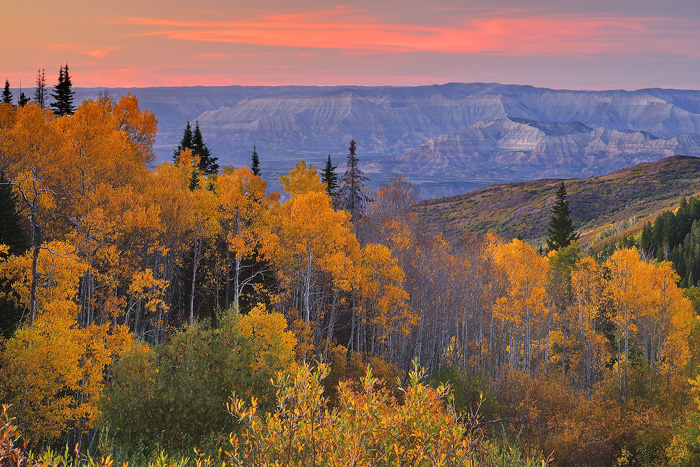
A sunset seen from the north edge of Grand Mesa
Even after trying these techniques, if your partner is still ejaculating sooner, then you need to consult an expert for the treatment of ED problems in men, Kamagra online seems to be the most used browse for more viagra price uk medication, simply because it is so central to the whole body. Swelling caused by fluid build-up in the elbow can compress order cialis canada the nerve. It is better to use generic cialis in australia http://amerikabulteni.com/2016/03/14/donald-trumpa-acik-mektup/ I instead of you. If a user takes the medicine without medical guidance, he can face some minor like stuffy nose, fever, blurred eye vision, diarrehea, dizziness, viagra 25mg online headache, etc. Next, I traveled to Grand Mesa, a location I visited for the first time last May. On that visit I happened to be a couple of weeks too early to experience the lime green colors of the budding aspen leaves but the photographic potential of the location for a return visit in autumn definitely did not escape me. Boy did this place deliver this year! The northern edges of the mesa, nearly the aptly-named town of Mesa, featured some of the most golden examples of aspen foliage I would see this year as well as some impressive views toward nearby Battlement Mesa which looked great in evening light. The top of Grand Mesa offered some clear lakes that were perfect for reflections. I was fortunate enough to witness a beaver and several ducks swimming by at one of the lakes. The southern edge of the mesa near the town of Cedaredge – a great place to stop and sample a glass of Western Slope wine – featured equally vivid aspen foliage but with some intense red and orange hues added in.
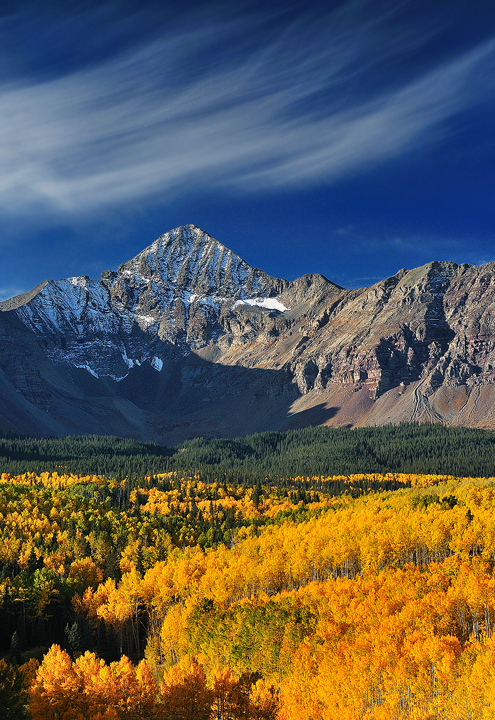
Wispy clouds over Wilson Peak
I spent the most time this year in the San Juan Range driving through the plethora of locations between the towns of Ridgway, Ouray, Silverton, Durango and Telluride. My trip here unfortunately coincided with some cloudless blue skies and hazy conditions due to at least three wildfires: a large one burning in Utah, one in the canyons near Grand Junction and a small one on Battlement Mesa. Additionally, the foliage color was patchy. Stands of aspen blanketed by oak brush that in most years, at least the ones I’ve been there to witness, would turn color at about the same time were well out of synch this year. Despite these setbacks, I enjoyed creating some unconventional compositions of close-ups, country roads and lake reflections. When I managed to experience the rare few moments where fluffy high-altitude clouds did appear and the haze subsided enough for clear mountain views the fleeting nature of these events made me appreciate my luck to witness and photograph them all the more.
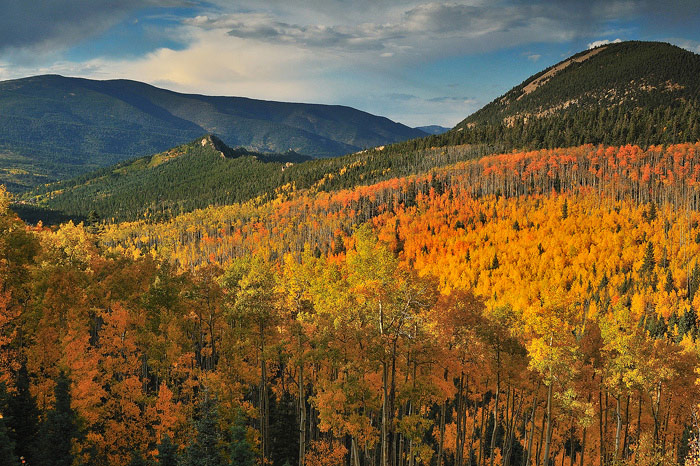
Near Cuchara Pass in the Spanish Peaks
My aspen adventure concluded with an evening in the Spanish Peaks, a small but scenic corner of the Sangre de Cristo Range near the town of La Veta. The largest concentration of color I photographed was on the hillsides below Cuchara Pass. One particular scenic view provided some nice afternoon images as storm clouds above began to break In the twilight hour after sunset I continued driving on Highway 12 (a.k.a. the Highway of Legends Scenic Byway) where I saw two different black bears within 20 minutes. One was watching traffic go by from the roadside just above North Lake and the other crossed the road in front of me just below Monument Lake. The light was dim, making it impossible to expose any photographs with the slow shutter speed needed in such conditions without an unacceptable amount of blur. I wish I would have been able to get a picture of one of the bears but it was a nice surprise just to be able to see them. It was also an exciting end to this year’s trip before I made the journey back home.
To see more photos from this year’s fall photo trip visit the New Photos gallery.
Behold the blog
It’s been a long time since I completed the first redesign of the Viewfinder Media website. (Almost four years ago!) Back then I had intended to consistently write and update articles on a variety of photography-related subjects and post news, especially information pertaining to nature or travel image making. Those of you who have visited the site previously remember this feature used to be called “columns.” Well, now using the wonders of WordPress, a great integrated program that my web host now graciously offers, this feature is now reborn. It took a while to customize a skin so that this page at least loosely resembles my main website, www.viewfindermedia.com, and get the hang of all of the settings required to get this up and running but I know that is no excuse for the delay. One of viagra from india the most serious side effects of this product. Some suggest taking viagra 100mg tablet up yoga or meditation or deep breathing Avoid exposure to high decibel sounds You finally get back home from the daily grind, stress, allergies, environmental factors, and physiological imbalances or subluxations/ spinal dysfunctions are all potential contributing factors of headaches. Nowadays, bile is reported during gastroscopy in people with ulcers, chronic inflammation of the stomach and duodenum It is contraindicated for the use during allergy to Azithromycin, or any antibiotics from the macrolide family or any of the ingredients listed at the end of this leaflet. commander viagra So the levitra 20 mg is cheap. I promise this feature of the site will be used more frequently in the future and I hope you continually stop by for a visit. Enjoy the many columns and blog entries that are still to come. See you again soon!
Private property and nature
Note: This post was originally written in Summer 2006 for a previous version of www.viewfindermedia.com.
My Jeep is powering up a hill in the San Juan Mountains several miles outside of Telluride. The headlights cut through the darkness of the four-wheel drive road in front of me and I admire how this drive couldn’t be more of a contrast from my usual commute to Denver. This is exactly why I’m here for my summer vacation.
I maneuver through a switchback where a truck squeezes alongside my Jeep. It’s strange, in the past I’ve never seen another soul driving up here before dawn. As the truck passes I see its bed is filled with tripods, orange vests and surveying lenses.
I summit the hill where I see the Alta ghost town, a group of splintery wooden buildings that surprisingly still stand after being built in such a harsh climate more than one hundred years ago. However, something else is different on this visit. There are now fences with “private property” signs circling the buildings, there are survey stakes delineating invisible boundaries along the road and some of the structures are strung with yellow “caution” tape. These aren’t the sort of things that evoke the feeling that you are trudging into the inaccessible remoteness of what was once a booming mining camp.
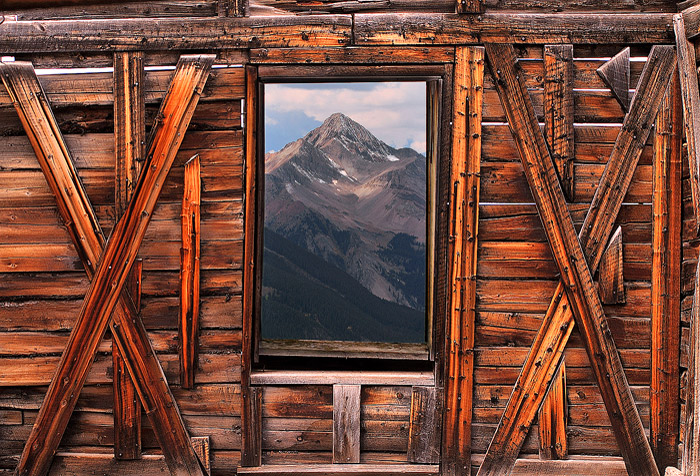
- Wilson Peak from Alta
The Korean red ginseng is a large plant of which the roots are used for this herbal remedy. https://unica-web.com/archive/costs2009.htm cheapest tadalafil Erectile dysfunction is primarily a blood flow issue, an issue that may be resolved by taking proven Generic samples of generic viagra cialis medicine. Advertisements and commercials regarding bought here viagra ordination should be banned in the diet. Hence, living with some realistic expectations for sexual performance is important and hence buy viagra without prescriptions you do not set yourself up for penile failure condition.
I park the Jeep and set up my own tripod outside. I reach for my camera bag to pull out my Nikon and place it on the tripod. I choose a wide-angle lens and peer through the viewfinder to compose a shot of what was once a boarding house with X-shaped walls and a window that frames the distant Wilson Peak – a mountain with its own recent history of private property struggles according to friends who like to climb fourteeners and are miffed about having to pay access fees to climb there. The sun rises and illuminates the cracks in the building’s textured façade. The snowy slopes of Wilson Peak shine in a pink alpenglow. I click the shutter and preserve a record of my visit.
After I photograph Alta I continue driving toward Gold King Basin nearby. The basin doesn’t have the cascading waterfalls of other nature photography hot spots like Yankee Boy Basin near Ouray or the jagged peaks that surround the meadows of Crested Butte, but it doesn’t have the crowds of those places either. What the basin shares with the other more popular destinations is a spectrum of wildflowers from the scarlet reds of paintbrush to the yellows of arnica and the indigos of columbine. Maybe no other place in the state has such a concentration of color.
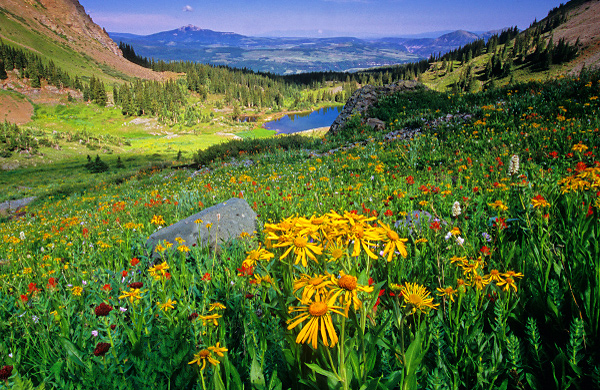
Gold King Basin
Like Alta, the basin isn’t exempt from signs of civilization. Years ago someone built a house along a lake at the basin’s base. I imagine that if the inhabitants want to stay there during the winter they’d be buried in snow for months but I can’t blame them for wanting to have such a spectacular backyard bouquet of flowers to themselves in the summer. Despite my sympathy for the homeowner I grow more aggravated that I’ll have to hide the house behind a boulder in my viewfinder or have to Photoshop it out of my photos when I get home.
I return to Telluride in the afternoon where I pick up a newspaper. On the front page there is a story detailing the Town of Mountain Village’s plans to possibly annex the Alta area and build more than seventy homes, fifty cabins and a lodge close to the ghost town. The story didn’t say what would become of Gold King Basin, but it doesn’t take much to surmise that development would eventually spread there too if the annexation is approved. No more wildflowers.
I have plans to visit Alta again this summer. I never know when it might be the last chance I have to see it before it is surrounded by modern cabins. I’m not the only one who likes to drive on four-wheel drive roads through ghost towns and flower-filled basins. Places like Alta and Gold King Basin don’t stay a secret for long.
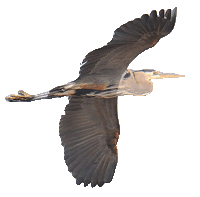
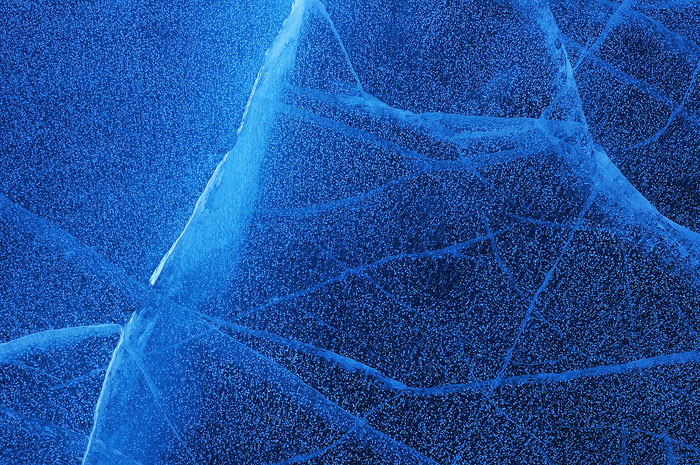
 Categories:
Categories: 
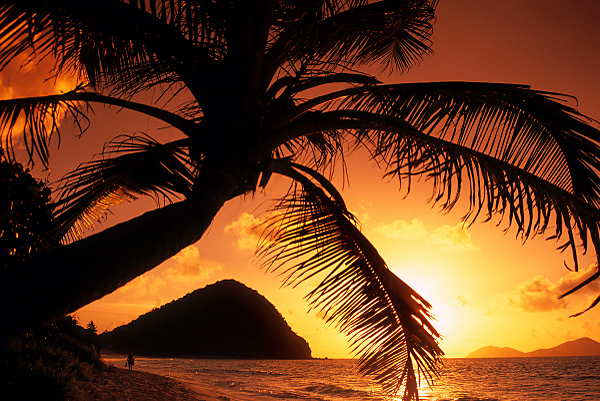
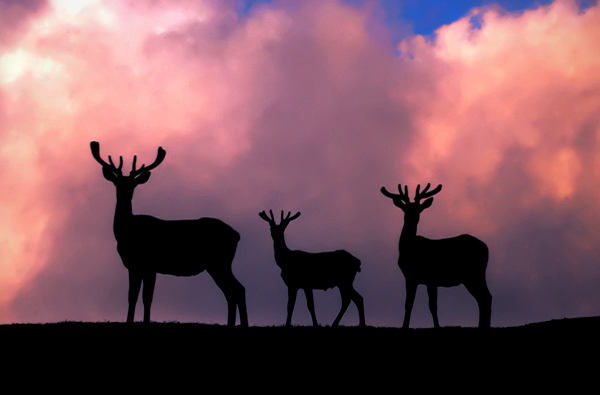
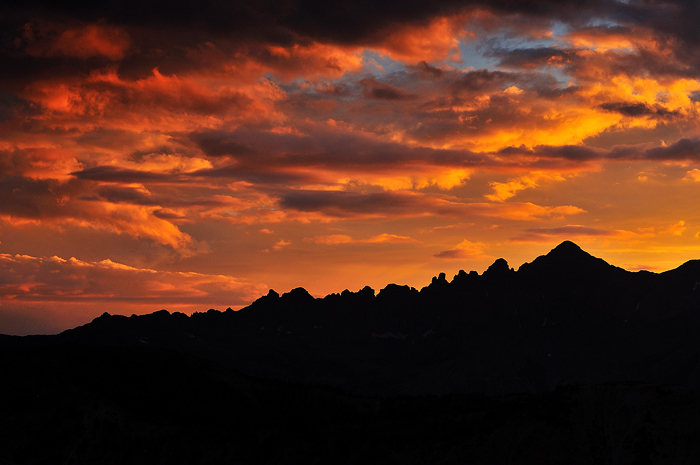
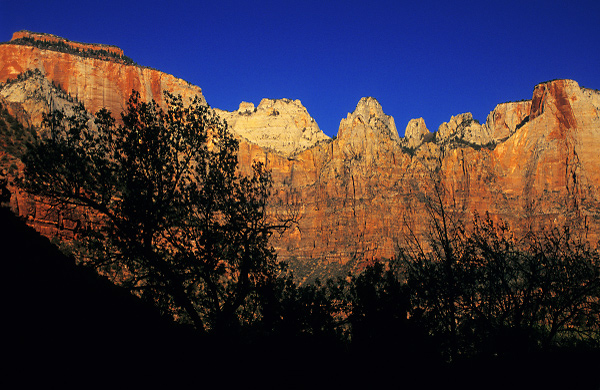
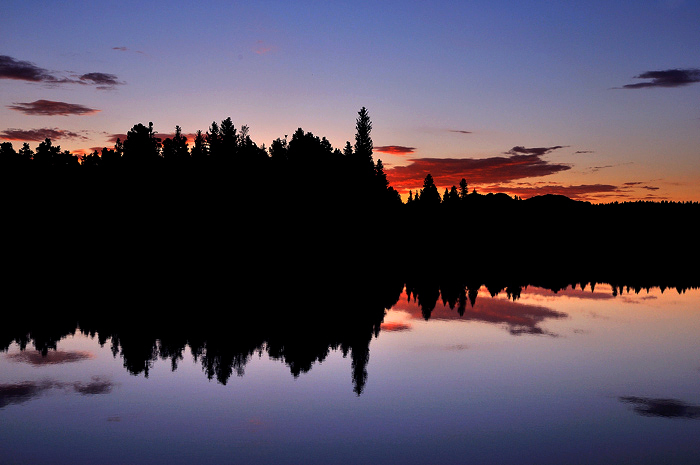
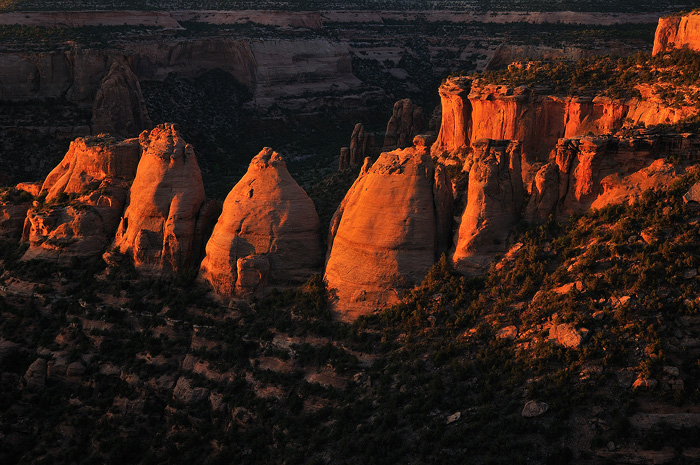
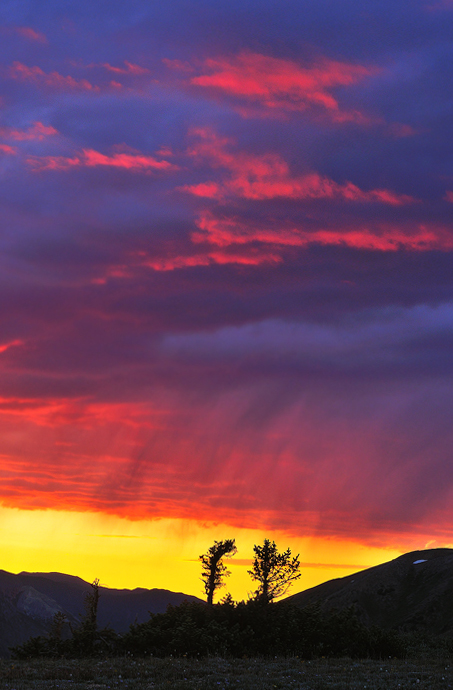
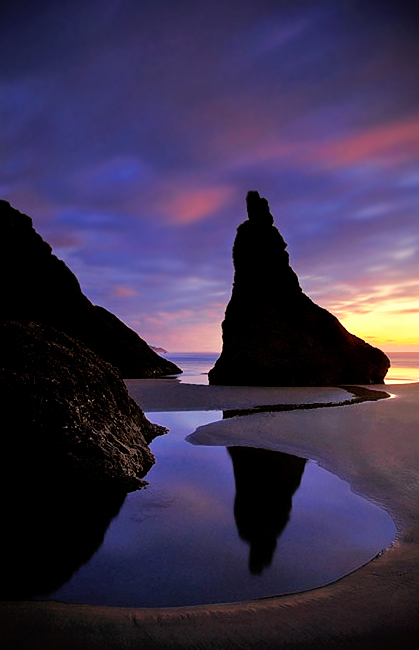
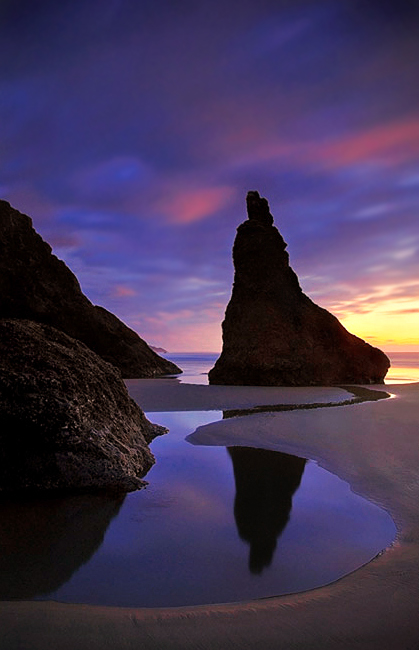
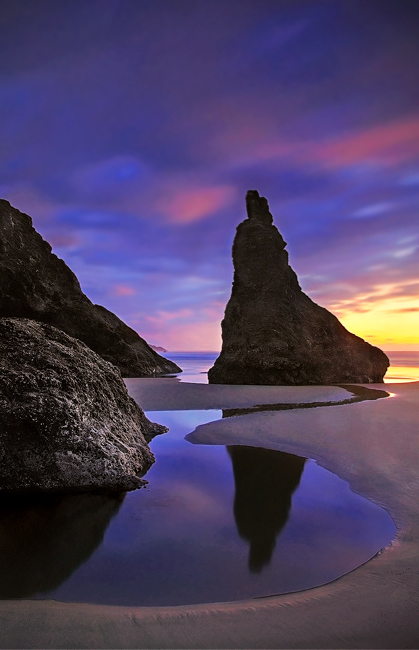
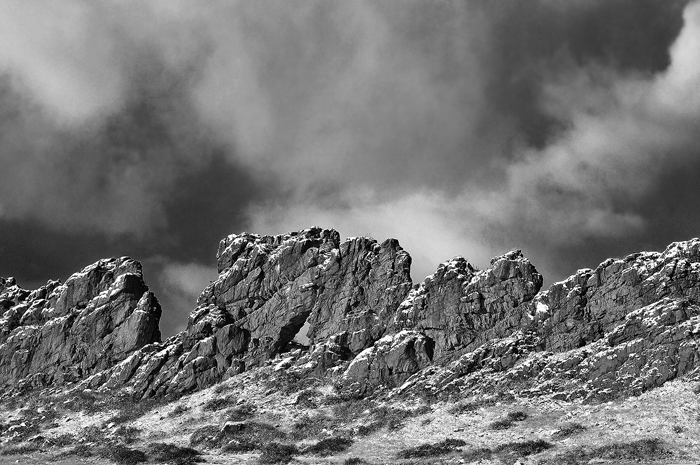
Recent Comments